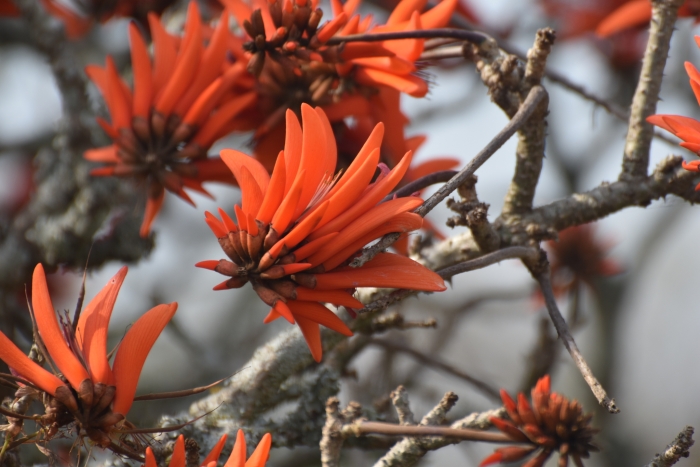Common Coral Tree
(Erythrina lysistemon)
Common Coral Tree (Erythrina lysistemon)
/
/

eustreptospondylus
CC BY 4.0
Image By:
eustreptospondylus
Recorded By:
Copyright:
CC BY 4.0
Copyright Notice:
Photo by: eustreptospondylus | License Type: CC BY 4.0 | License URL: http://creativecommons.org/licenses/by/4.0/ | Rights Holder: eustreptospondylus | Publisher: iNaturalist | Date Created: 2023-08-04T13:24:15-07:00 |

























Estimated Native Range
Summary
Erythrina lysistemon, commonly known as the Common Coral Tree or Lucky Bean Tree, is a deciduous tree native to the open woodlands and grasslands of South Africa. It typically grows up to 39 feet (12 meters) in height and is noted for its smooth grayish bark and hooked prickles that can be found along its branches. The leaves are trifoliate, meaning they are composed of three leaflets. This tree is particularly striking when in bloom, as it produces dense racemes of scarlet red flowers in the spring before the leaves emerge, creating a vivid display that is highly attractive to birds, especially sunbirds which pollinate the flowers.
The Common Coral Tree is valued for its ornamental qualities, including its showy flowers and its ability to provide shade. It is often used in tropical and subtropical landscapes for its aesthetic appeal and is also planted for erosion control due to its robust root system. In cultivation, it requires full sun to partial shade, moderate water, and well-drained soils. While it is relatively low-maintenance once established, it is susceptible to frost and should be protected in cooler climates. It is important to note that the seeds of Erythrina lysistemon are considered toxic if ingested.CC BY-SA 4.0
The Common Coral Tree is valued for its ornamental qualities, including its showy flowers and its ability to provide shade. It is often used in tropical and subtropical landscapes for its aesthetic appeal and is also planted for erosion control due to its robust root system. In cultivation, it requires full sun to partial shade, moderate water, and well-drained soils. While it is relatively low-maintenance once established, it is susceptible to frost and should be protected in cooler climates. It is important to note that the seeds of Erythrina lysistemon are considered toxic if ingested.CC BY-SA 4.0
Plant Description
- Plant Type: Tree
- Height: 15-30 feet
- Width: 15-30 feet
- Growth Rate: Moderate
- Flower Color: Red
- Flowering Season: Spring
- Leaf Retention: Deciduous
Growth Requirements
- Sun: Full Sun
- Water: Low, Medium
- Drainage: Medium
Common Uses
Bird Garden, Butterfly Garden, Drought Tolerant, Showy Flowers
Natural Habitat
Native to the open woodlands and grasslands of South Africa
Other Names
Common Names: Lucky Bean Tree, Sacred Coral Tree, Coral Tree
Scientific Names: , Erythrina lysistemon, Erythrina caffra var. mossambicensis,
GBIF Accepted Name: